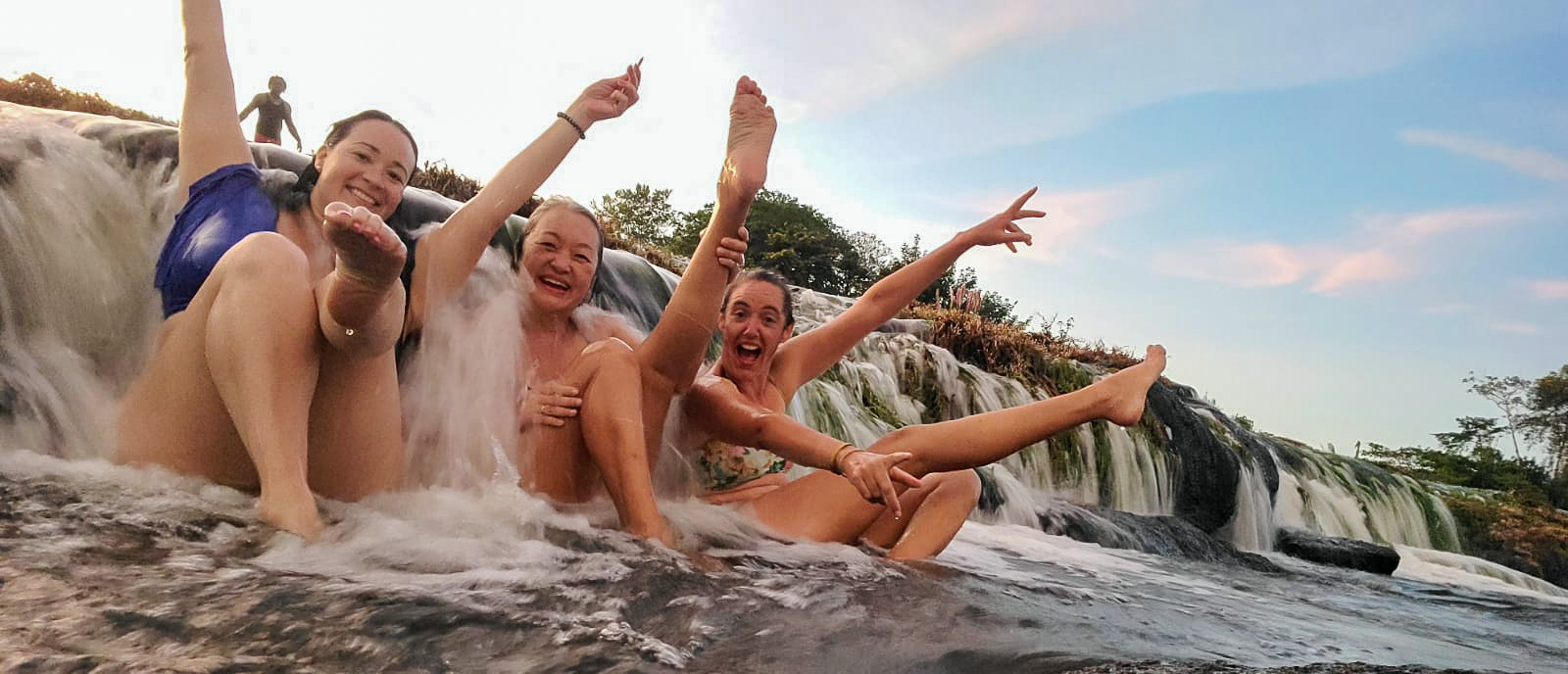
Saamaka River Experience
The Saamaka are the Maroon Africans living along the Suriname River. No, that's not them above — they're my wonderful companions on this adventure!
The Suriname River is big, flowing about 2kn at Domburg where Anjea is moored — wide, brown and dirty, carrying the flotsam and debris of all the communities it serves on its several hundred kilometre course. Suriname is not a populous country. It's 600,000 inhabitants live mostly in the one and only city, Paramaribo, with the rest spread out in communities along the rivers. These communities are African, descended from slaves who ran away from the cotton plantations 200 years ago seeking a better life. They found a gentle land, not dissimilar to their faraway homelands, and proceeded to carve out an independent existence, learning what this new world had to give them, and how to deal with its threats.
They survived, their population grew, they spread further inland along the rivers and were left pretty much to themselves until the 1960's when BHP and Alcoa wanted to smelt bauxite. Bauxite is plentiful here and today it is one of Suriname's major exports, along with gold, but to make aluminium from it you need electricity — lots of electricity. And so they dammed the Suriname River at Brokopondo. The hydro scheme was a flop and the smelter eventually closed because there was insufficient power. It's not that there wasn't enough water so much as the height, or rather the lack of it. Suriname is flat. It's highest peak is just over a thousand metres and that is a long way inland. Truly vast quantities of water are needed to sustain a hydro powered aluminium smelter. Anyway, someone got their figures wrong and the smelter closed leaving the dam and the lake it created.
The hydro scheme displaced many villages along the lower river. The villages flooded by the dam were moved to new villages downstream and further away from the river. This wasn't a good move as the villagers' life style is dependant on the river.
In contrast, the upstream villages were left alone to live more traditional lives, despite the dam causing occasional flooding, and their culture is very much alive. Each village has a headman and the loose confederation of all the villages along this part of the river is known as the Saamaka.
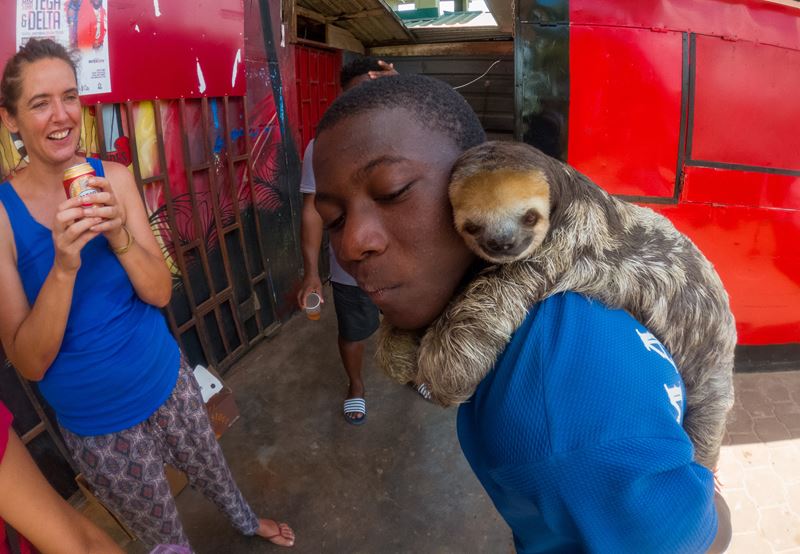
At a stop along the way to Atjoni Merel is fascinated by a boy with a captured sloth.
Clarins is driving us to Atjoni, a town just above the lake. Clarins is Saamaka and is a village chief and a policeman. He picks me up from Domburg. Merel is already on board along with Ida and Silicia. We spend the couple of hours it takes to get to Atjoni getting to know each other. Ida is the military attaché at the US embassy here and Silicia was a French language teacher in the US and is married to a French mine manager. Both are strongly opinionated women. Ida is on a crusade for equal opportunity. Silicia agrees but is much more diplomatic. Merel is an enthusiastic supporter. I make sympathetic noises but am otherwise silent. It's not that I disagree with the principles or ideas, I just don't understand the motivation.
Ida has Colombian heritage thru her mother's side, and is proud of it, but she was born and raised in Texas. She gives me her phone to take a picture of her. "Never drop the camera below eye-level" I am instructed as I lower the camera to chest height for a better background. "It shows people's double chins." I didn't say that there are better ways to lose that double-chin than lifting the camera. Ida is a big woman. Average height, but heavy. I guess she'd be in her 30's and a career naval officer. I obey. Merel and I are instantly impressed by anyone who drives a destroyer for a living.
I try three times to get Silicia's name right. I thought she said 'Felicia' but she's obviously been thru this many times and perseveres until I get it right! She was born in Mauritius, a collection of beautiful islands in the Indian Ocean that, unfortunately, I have not yet visited. She is a native French speaker but her English is perfect, with just a hint of Asian accent to go with her Asian features. Once again I feel diminished in my ability to speak just one language. Everyone else in the car is fluent in at least two languages, as are almost all the people I will meet in the next several days.
Merel speaks Dutch, which is the official language of Suriname, but most people also speak a local language that is a mix of African and European words, in an African syntax. English is also widely spoken, especially in Paramaribo, but not so much amongst the Saamaka.

Atjoni is where the river journey starts.
We arrive at Atjoni, the river port where our journey really starts. It's a hectic place packed with cars, long narrow canoes and hundreds of people, mostly of African ancestry, milling about, shopping in the ever-present Chinese supermarkets, waiting for a boat, a bus or a car. Here we are met by Belé, our organizer and guide, with his offsider Javeh, a big strong fit-looking African who rarely smiles. We are quickly bundled into his canoe and are soon underway travelling back down the river towards Lake Brokopondo.

Three strong women and one confused guy.
The river is fast and shallow with rocky rapids that we shoot thru with confidence. Confidence on the part of Javeh, that is, and fearsome apprehension on my part. After an hour or so the river opens out into the lake. It's a gradual widening with no fixed shoreline. This is a flooded landscape of small hills, now islands, with the bare boles of the forest trees still standing. Javeh keeps to the old river course and after another 30 minutes or so of winding about between islands we arrive at Stuwmeer, the village that is our destination for the night.
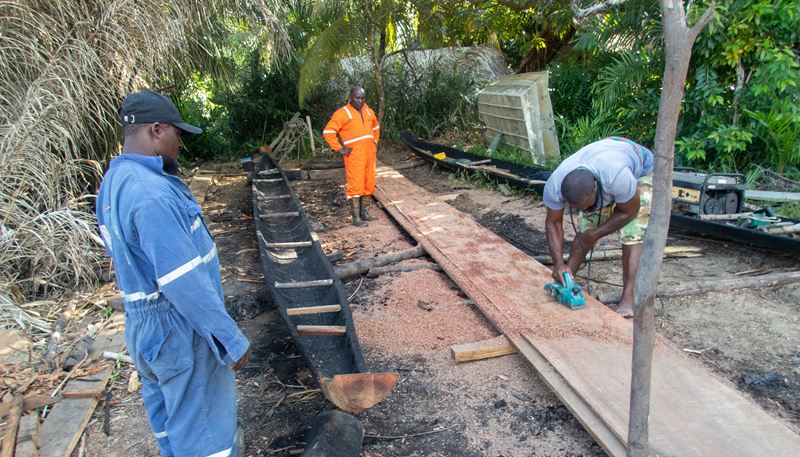
Building canoes. The hull is constructed from a single hollowed out log, on the left. The sides are built from solid slabs of timber being planed by Javeh on the right.
Stuwmeer is an unusual village that we are seeing at an unusual time. First, it is a men's working village where they build the canoes that ply the river. And second we have arrived on a holiday so the place is full of children and their mothers who have come here to be with the men for a change. Normally, the women and children would be back at their home village and the children would be at school.
The hull is made from a single log, carved and burned out to create a structure strong enough to withstand grounding and even hitting the occasional rock at high speed. The hull is about 100mm thick. The sides are lighter, just 30mm or so, but still solid hardwood. There are no frames or stringers but the seats provide some additional support for the sides. At the back is a 40hp Yamaha outboard.
I see one canoe with an enormous drum of diesel, a refrigerator and several other whitegoods. It's about 20m long and powered by an 80hp Yamaha. Everything along the river goes by canoe. Even the posthole digger I later saw at Jaw Jaw came by river, maybe on that gigantic canoe.
The plumbing here is below average. A hole in the ground with blue plastic wrapped around some sticks for privacy. Remember to bring your own toilet paper. No bucket required. Reminds me of boy scout camps as a kid.
As the heat starts to moderate we collect rods and hooks and get back in the canoe to try our luck at catching dinner. Javeh catches two or three piranha, Belé catches a couple and Ida is just itching to catch one. She has a score to settle with the piranha that took a chunk out of her toe a year or so ago and carefully copies Javeh's technique. We all get nibbles but the trick is in hooking the buggers before they escape with a free chicken dinner. Suddenly, Ida has one and pulls it aboard where Belé crowns it with the back of a machete. Ida is overjoyed at her revenge and demands more chicken! In the end she catches more than anyone else and truly enjoys her revenge on the piranha that tried to eat her.

Silicia catches a piranha.
With the tables turned, we dine on piranha that night and they are good eating: white, delicate flesh with a mild pleasant flavour.
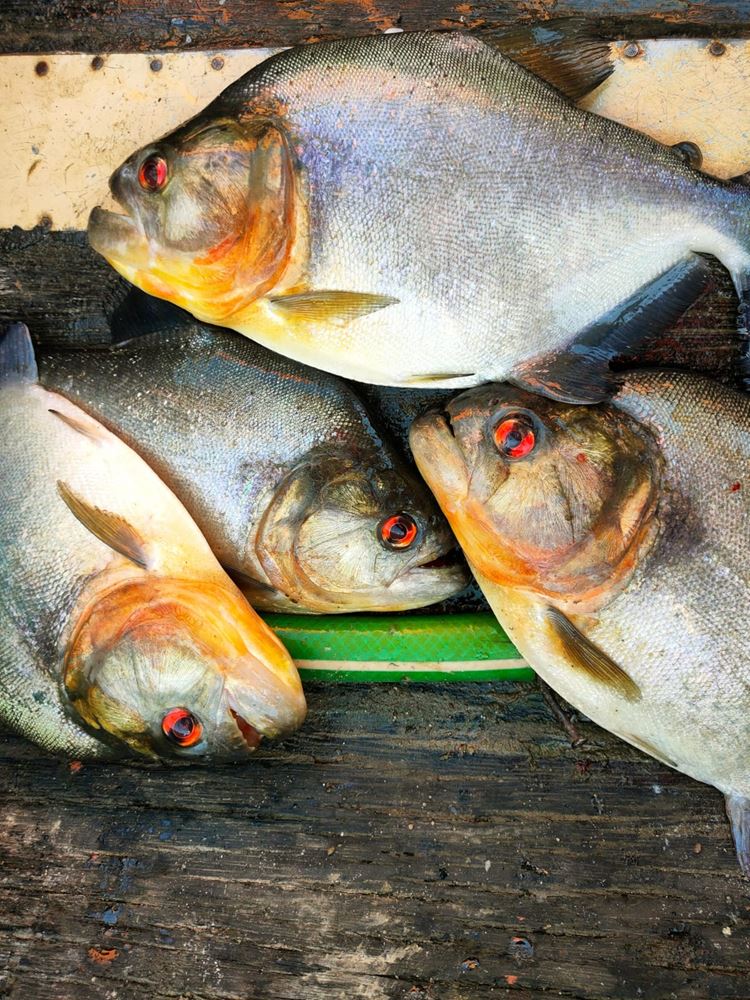
Dinner
The canoes are formidable. Ours is about 12m long and 1.2m across and seats ten people in reasonable comfort, with the first few seats taken up by our packs and supplies. The seats are just bare wood. There is room for two people on each seat but it would be a squeeze. We have the luxury of a seat to ourselves and can sprawl out a bit. But balance is critical: if one of us leans to the right someone else must lean to the left or our captain gets upset.
There is no shade. Belé hides under a shawl, busy on the phone. Merel wraps a shawl over her head. Silicia has an excellent broad hat. Javeh sits or stands at the back, hanging on to the outboard and exposed to the elements. I sit under my Foreign Legion style kapis in long sleeves. So long as we're moving it's quite pleasant with the wind to cool us and the occasional spray from the bow wave, but it's easy to get burned. Silicia and Ida suggest to Belé that we need shade covers on the canoe, as they have on the taxi canoes around Parmaribo. I don't think he was convinced.
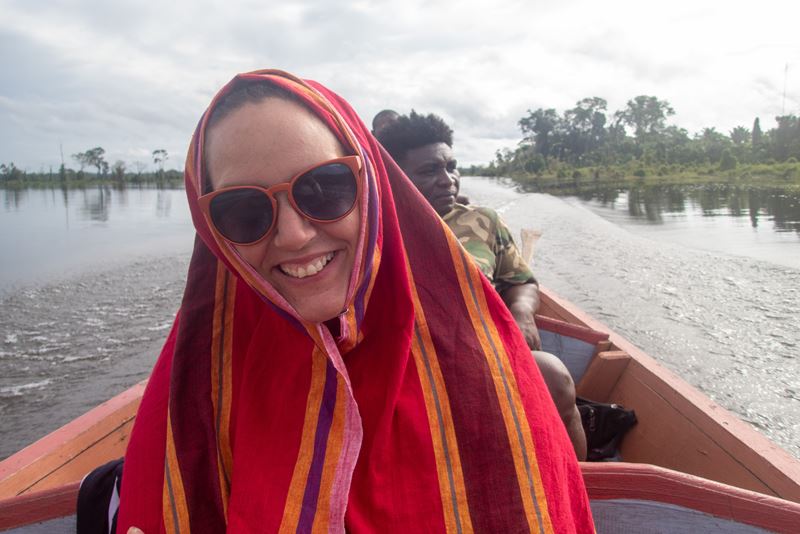
Merel borrows Clarins sunglasses and a matching shawl to keep the sun off.
Next day we retrace our route back to Atjoni. I guess the canoe does about 20 knots (35 kph), a bit less when travelling upriver and even less again when negotiating the numerous rapids. This time we have a couple of bumps from rocks and then, right in the most treacherous part of the rapids, the propeller collects something and snaps the splines. The splines are a fail-safe that prevents worse damage to the engine from the prop hitting an obstacle. Javeh did his best but we were washed back downstream and forced to pull over while he changed to a spare.
According to Belé, "Kambalua is a village where is NOT touristic." Well, they coped with us visitors very well. We were guests of the chief's son and one of his wives. She was one of the few people we met that spoke good English. She was also a very beautiful and a quietly strong and independent person.
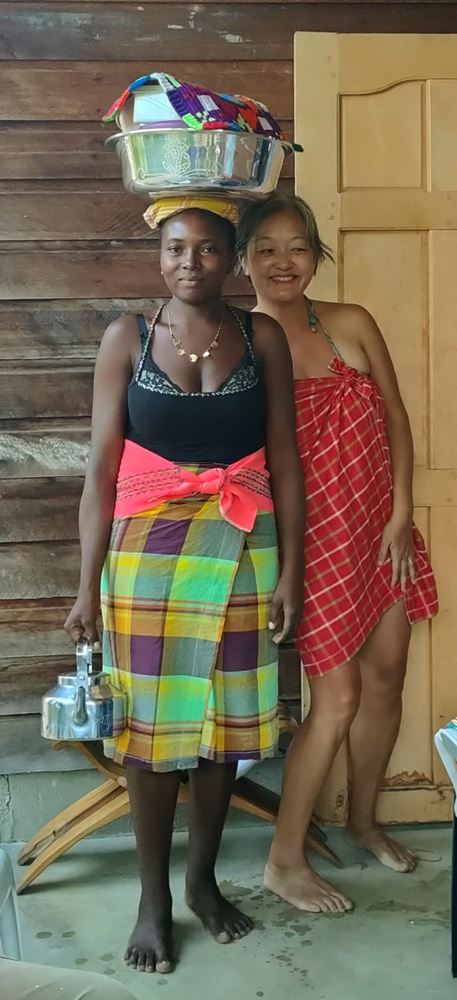
Our hostess, the chief's son's wife, and Silicia
Belé was concerned that we obeyed protocol while we were guests of the village. When Ida, Merel and Silicia went off to explore the village he was worried. "There has been a death in the village and the wake is still in progress", he explains to me "I want everyone to stay here and not wander around."
The ladies eventually return without having ruffled any feathers and when the situation is explained they want to see the wake. So off they go with some of the locals to guide them and all is well. A wake goes on for days or weeks with much story-telling and celebration before the body is finally buried.
That night we are treated to some song and dance. The village women come to our hut and sing a cappella. They are very good. Two women call the lines and dance an intricate step, then the chorus of about a dozen women respond and clap to the beat. After the third or fourth song everyone is laughing so much Belé has to translate. The main line went something like this:
The men in our village are not natural.
They all take Viagra.
But the men in our village are no good!
The other key thing you need to know is that there is a potent local drink made with cheap whisky, cinnamon and other spices, that is very popular with the men. It's nickname is Viagra. I tried it. Doesn't work.
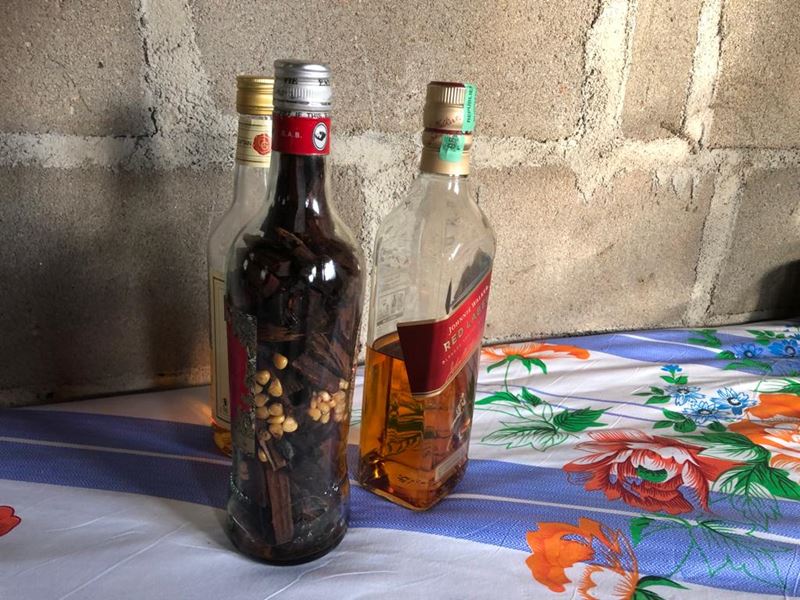
'Viagra' is a sweet liqueur made from whisky and a host of herbs and spices.
Until Belé translates and explains of course we don't realize it's a ribald joke, but everyone else does! Our trio of women think it's great but the tribe's men look a bit sheepish. Although everyone laughs there is obviously an element of truth to the accusation and song is a legitimate means for the women to express this publicly.
The women's singing is followed by more dancing, this time by the children, and they are truly amazing! I call them children but they are adolescents in their early teens and unlike the older women they dance in mixed pairs in a closely choreographed, but wild and intoxicating, hip-swivelling, bottom-shaking gyration.
The plumbing here is average. There is a toilet bowl but it's flushed with water from a bucket.
Next day we cross the river to the village of Dan where we meet the headman, and then continue upriver a bit to Danpaati, a resort partly owned by the village, where we are meant to taste the local coffee, but have a beer instead. The resort is built to look traditional and has real thatching for a roof. Belé says it lasts up to 20 years, but every six months they must light a smoky fire inside and close it up for a few hours to kill off all the bugs that would otherwise eat the roof.
Then on to Piking Slee where we have lunch at the Saamaka Museum before our guide shows us around the museum itself. The presentation is in Dutch. Belé does his best to translate but I find it difficult to follow and fail to ask the questions I'd been wondering about.
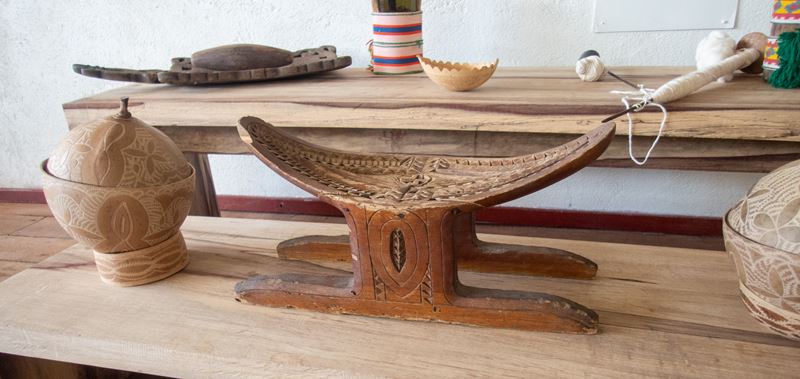
The Saamaka are expert woodworkers.
Next day is our last travelling upriver and we sit in our canoe for 3 hours through countless rapids as Javeh blasts upstream, following other boats where he can. If they don't hit a submerged rock then neither will we!
We pass fewer villages as we go but I am still surprised by the number of people and boats. The river splits in two at our destination: one tributary is blocked by a low waterfall called Tappawatra Falls and the other, where the village of Asidonghopo lies, peters out to a small creek a bit further up. We take the second branch and head for the village to make ourselves known. It's a very nice arrangement and I get to sleep in a bed instead of a hammock for the first time.
The plumbing here is average. There is a toilet bowl flushed with water from a bucket.
The heat fades a little and we pile back into our canoe for one of the highlights of the trip: Tappawatra Falls. It's just five minutes and we have them to ourselves. A little cautiously at first, we start exploring. We climb and wade to the top. Boring. We lie in the pools, nice but boring. And then we discover sitting under the falls. Heaven! Each step of the falls is only a metre or so high, but the volume of water is such that it's hard to hang on. The pummelling is worth it though — it's the best massage ever! Definitely not boring.
Next morning we are awake before dawn for the walk to Pineapple Mountain. It's about an hour but we'll be doing it in the dark so it might be a little longer. Sporting headlights, long pants and long sleeves we set off into the jungle with our guide leading the way, shotgun at the ready. The shotgun is for wild pig and deer. There are big cats too, Jaguars, but we've not heard of anyone being attacked. It seems Jaguars prefer easier, smaller prey and generally stay well clear of people.
The footing along the track is a bit difficult and I have to keep my wits about me to stay upright. Our guide sets a good pace. We cross several shallow streams with just a single log to walk across. Ida misses her footing and steps into the water, then I decide I have gotten to the other side and step off into thick mud instead of the solid ground I am expecting. Everyone else stays dry. It's very dark and we would not have a clue where the track is if it wasn't for our headlights.
The jungle thins out as we approach the base of the mountain and there is enough light to see by. The rough muddy track is now solid rock underfoot and is heading up to what we can see is a large basalt knob: Pineapple Mountain. You don't have to be Einstein to know that everything is relative. Here in Suriname, which about as hilly as the average pancake, this is a mountain! Two puffs and a pant and we're at the top. The GPS says altitude 107.8m. That's altitude above sea-level and our 'mountain' is about 30m above the jungle, so most of Suriname is about 70m above sea-level. That's flat!

Sunrise from the top of Pineapple Mountain.
I like to watch the light fill in as the planet spins to face its star once again. It's a special time. As the stars go out the first light is dull, just an easing of the shadows, then shapes and details define themselves, and finally our own star reaches over the horizon to stare down at us, eight minutes late as always. This particular sunrise is nothing special. The sky is thin cloud and we get no more than a few streaks of pink and some wisps of mist over the greenery below us, soon burned off as the sun climbs higher.
It's called Pineapple Mountain, I think, for two reasons: first, it is kind of like a squashed pineapple in shape. And second, because pineapples grow all over this otherwise pretty bare rock! Or rather, pineapple plants — because the pineapples themselves are gone. By the way, pineapples in Suriname are fabulously sweet and juicy with soft but crunchy cores. Nothing like the acidic stringy things they call pineapples in southern Australia.
The walk back is uneventful. We see no wild pigs, no deer, no snakes, no jaguars, not even a monkey, and nobody falls in the creeks or steps in the mud.
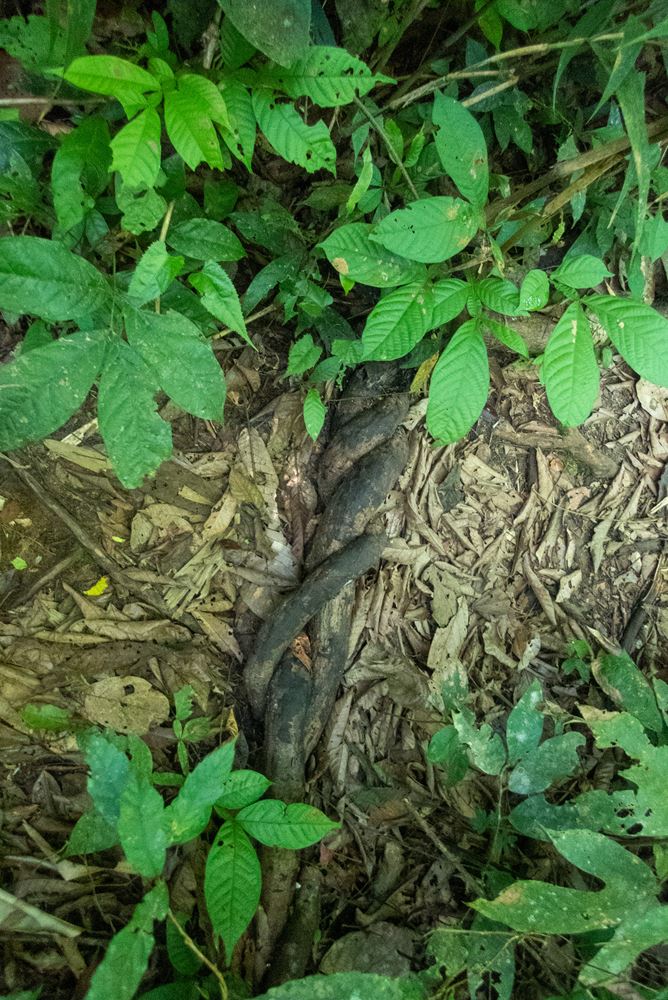
The track is narrow and tricky.
This is as far as we go. From here on we are heading back home, though it will take a couple of days to get there. Before leaving we are primed for another pummelling at Tappawatra Falls but even before that there is someone we must meet. This is a bit of politics, a bit of theatre too, but mostly just politeness: we must meet the chief of the Saamaka people, the headman, the 'king', who just happens to be on the other side of the river.
He's dressed in a golden jumpsuit. Yes, I know. If you dressed in a golden jumpsuit, I would laugh. But Kings can do that you see, and get away with it! Belé introduces us and he's got a word or two for each of us and it does really seem a stately occasion despite the fact we're out in the Suriname jungle talking to the descendant of a runaway slave, dressed in a golden jumpsuit.
Politics played, we jump back in our canoe for the short trip to Tappawatra Falls. This time there is no exploration, no hesitation, we just head straight for the pummelling falls.
Mellow and relaxed after our 'mountain-climbing' and watery massage we reluctantly pile back into our canoe for the three hour trip downriver to the last overnight stay at Belé's home village, Jaw Jaw, pronounced as a guttural Dutch 'Hyow Yow'. It's a fast trip with many rapids to negotiate. Just a momentary loss of concentration and the canoe would end up on a rock or overturned, but Javeh gets us there without incident. We are blazé now and have total confidence in Captain Javeh.
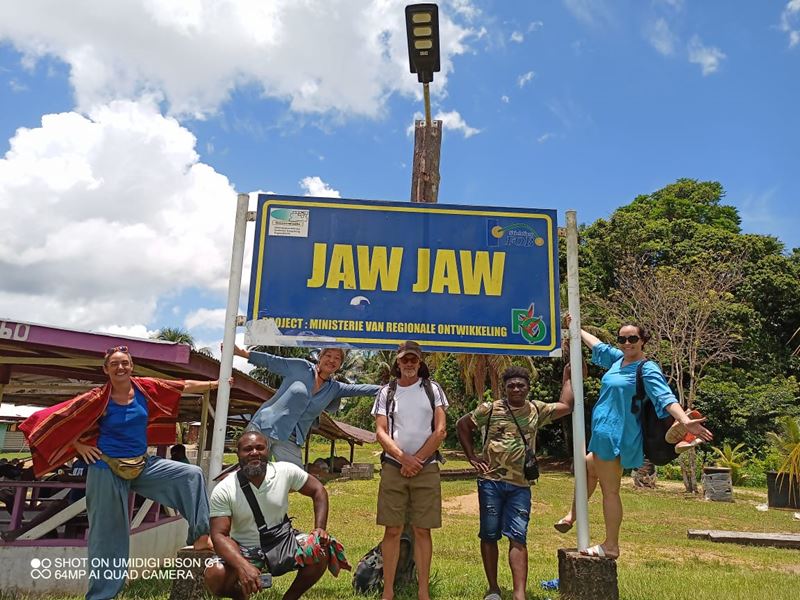
Belé, Clarins and Javeh are welcomed by everyone as we walk from the canoe to Belé's enclave at the far end of the village. It's a collection of beautiful wooden huts. Merel gets a hut, I get one to myself too, and Ida and Silicia share. The huts are traditional with intricately carved doors under a wide porch that has room for a hammock. The roof looks like thatch but on closer inspection is sealed with plastic sheeting. Inside my hut is a huge king-size bed. And there is electricity!
All the villages have generators but they are only used in the evenings and finding a spare socket on the tree of double adapters and plug boards is challenging. So finding electricity in my hut is a pleasant surprise and allows me to recharge my gadgets.
This is the first major trip I've done without the trusty Nikon and its wonderful 28-300mm zoom lens. Unfortunately, the Nikon is no longer reliable, the lens has had a bash and it's not waterproof. Bringing it would have been an exercise so I brought the GoPro and little Olympus Tough instead. For stills, they are both disappointing but they do video, which the Nikon can't. So I experiment with a mix of stills and video. The still pics are in the GALLERY and Merel has put together a video:
It's our last day in Jaw Jaw and Silicia and I walk in the bush with Clarins. I am hoping for some wildlife but it is obvious we won't see anything: the track is a churned up mess from logging operations. Clarins explains that when he was a child he walked this track with his parents to harvest cassava from their garden, which was sited away from the village to reduce theft! We see a few gardens growing cassava, banana, avocado, pawpaw and other things, but as Clarins explains, they harvest and forage from the bush as well. Clarins spots a monkey in a distant tree, Silicia says there are two, I fiddle with the camera, point it in the direction Silicia indicates and shoot. I think I can see them, but there's nothing there when I look at the pics later. With the Nikon and its proper viewfinder I would have got it.
I am tired after the walk, disappointed at not seeing any wildlife, missing the Nikon and feeling strangely low at the end of our trip. Normally, my wonderful and lively companions in this adventure would have me excited and happy, as I have been until now.
Finally, back in Domburg it is a relief to find Anjea still secure at her mooring. It is always a concern when I've been away, and I pour myself a very big scotch. It doesn't help my mood, but I sleep. Next morning I have a hangover, but the weather is clear, my devils have gone and I'm just tired, and very happy to be back where the plumbing works just fine, no buckets needed.
It was a great trip that I am glad to have participated in. Belé runs a variety of river cruises and also has an excellent and reasonably priced guest house in Paramaribo. Contact him on +597 83-5611 for more details, or Google Un Pied-A-Terre Paramaribo.
Photo credits: Belé, Ida, Silicia, Merel, and me.